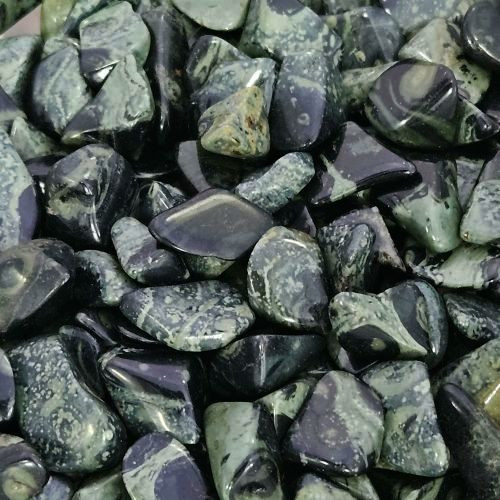Product Description
Jasper Leopardskin aka Rhyolite White Tumbled Stone
Mineral Information:
Leopard Skin Jasper is a trade name for a variety of rhyolite.
Rhyolite is a type of igneous rock that is formed through volcanic activity. It is composed primarily of silica-rich minerals, such as quartz and feldspar, and is known for its fine-grained texture and variety of colors. Rhyolite is chemically similar to granite, but it differs in terms of its texture and formation.
Rhyolite forms when highly viscous lava or magma cools and solidifies relatively quickly on the Earth's surface or in shallow volcanic environments. The rapid cooling prevents the formation of large mineral crystals, resulting in the fine-grained texture characteristic of rhyolite. The composition of rhyolite consists of a high percentage of silica, typically greater than 68%.
The colors of rhyolite can vary widely, including shades of gray, brown, green, pink, or red. The specific coloration is influenced by the presence of different minerals, such as iron oxides or other trace elements, within the rock.
Rhyolite often exhibits interesting textures and patterns, including flow banding, small cavities, or vesicles, and even embedded crystals. These features add to the aesthetic appeal of rhyolite and make it a popular choice for ornamental purposes, such as in decorative stones, jewelry, and architecture.
Metaphysical Meaning:
Leopard Skin Jasper aka Rhyolite is believed to possess grounding and protective energies. It is associated with strength, stability, and connection to the natural world. It is said to promote self-healing, balance emotions, and enhance one's ability to adapt to change. Leopard Skin Jasper is also thought to stimulate creativity, encourage self-confidence, and aid in spiritual discovery.
Mineral Care:
Rhyolite, as an igneous rock, is generally considered to be a durable and sturdy material. However, the fragility of rhyolite can vary depending on its specific composition, structure, and any potential weaknesses or inclusions present within individual specimens.
Here are a few factors to consider regarding the fragility of rhyolite:
-
Porosity: Rhyolite can have varying degrees of porosity, which refers to the presence of small open spaces or pores within the rock. Higher porosity levels can make the rock more prone to absorbing liquids or staining, but it doesn't necessarily affect its overall fragility.
-
Inclusions and Fractures: Rhyolite may contain natural inclusions, such as mineral deposits, veins, or fractures, which can weaken the overall structure of the rock. These internal flaws can act as weak points, making the rock more susceptible to breakage or chipping if subjected to excessive force or impact.
-
Weathering and Erosion: Over time, exposure to natural weathering processes, such as wind, water, or temperature fluctuations, can affect the integrity of rhyolite. While it is a durable rock, prolonged exposure to harsh weather conditions can lead to gradual deterioration, such as the erosion of surface layers or the widening of existing fractures.
To minimize the risk of damage to rhyolite, it is advisable to handle it with care, especially when moving or transporting larger pieces. It is also important to avoid subjecting rhyolite to strong impacts, such as dropping or striking it against hard surfaces. Storing rhyolite separately from other hard materials can also help prevent accidental damage.
Regular inspections and gentle cleaning using mild cleaning agents and soft materials can help maintain the appearance and integrity of rhyolite.
Disclaimer:
No information here is intended to diagnose, treat or cure ailments or afflictions of any kind. One should always consult a medical professional if a serious issue presents itself.










